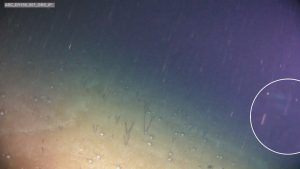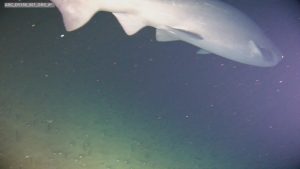Nature Notes – Bluntnose sixgill shark (Hexanchus griseus)
1 May 2023
Conservation
During the Discovery expedition on the 19th of November at 3:45 am, 250 metres deep at Grattan seamount, we noticed something glinting in the darkness...a pair of eyes. These eyes belonged to the bluntnose sixgill shark. A primitive-looking shark that lives in the deep ocean.

Image 1: The glinting eyes of the sixgill sharks.
These sharks live in the tropical and temperate waters worldwide such as the Atlantic, Indian, and Pacific oceans. It's the largest of the hexanchiform sharks, growing to a maximum length of 8 metres. The largest ever caught was in Ascension and weighed 588 kg.
As the name suggests, this shark’s snout is blunt and wide and its eyes are small but a beautiful fluorescent blue-green. There are 6 rows of saw-like teeth on the shark’s lower jaw and smaller teeth on their upper jaw. While juveniles have short and flexible jaws, mature male sixgills have rigid, calcified longer ones. Their skin colour ranges from tan, through brown, to black with darker spots staining their fins that get darker as they mature. Male sharks sexual maturity is determined by the length of their claspers.
Weighing over 500 kilograms (1102 lbs), the Bluntnose sixgill shark feeds on a wide variety of prey. This includes a diverse selection of fish, rays, chimaeras, squid, crabs, shrimps, seals and other smaller sharks.
Due to their diet, the bluntnose sixgill shark is classified as a generalist species and is less likely to be affected by scarcity in any one of its food sources .Although, the sixgill is classed as “near threatened”. Its longevity and popularity as a sport fish makes it vulnerable to exploitation and unable to sustain targeted fishing for very long, it is also found in only deep waters ranging from 180m - 2500m (590 ft. - 8202 ft.).

Image 2: A close encounter with a sixgill shark during a deep sea camera survey while onboard the Discovery.